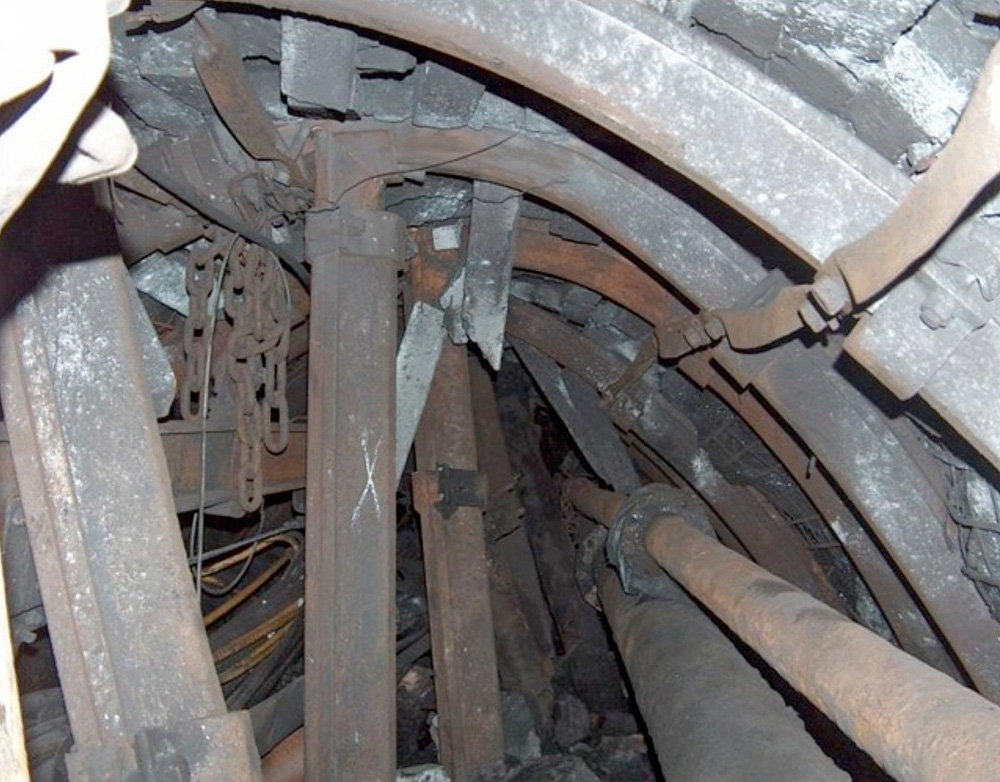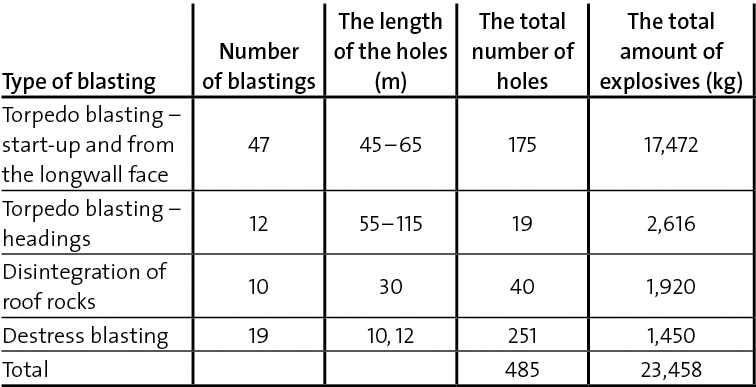Introduction
Seismicity induced by conducted mining exploitation is observed in many basins of global mining. In Poland, this phenomenon has been occurring for several years, among others, in the region of the Upper Silesian Coal Basin (USCB), in the area of LGOM (Legnica-Głogów Copper District) where copper deposits are exploited and in the Bełchatów area where brown coal is exploited opencast. In the region of the USCB, seismic activity induced by mining works was recorded already in the first half of the 20th century. It was particularly evident in the 1950s. Currently, despite the limitation of coal extraction, there is no significant reduction in the unit of energy output per ton of extraction (J/t). Analyzes have shown that this is associated with conducting exploitation at increasingly deep depths and an increasing concentration of exploitation in the regions of the influence of remnants and exploitation edges. The maximum depth of mining works is currently around 1,300m.
The seismic hazard and the resulting rockburst hazard occur in most mining plants and hard coal mines in this region. The analysis of the registered phenomena has shown that the main cause of occurrence of tremors is the violation of the primary balance of rock mass by mining exploitation. It also allowed to divide the recorded mining tremors taking into account the probable cause of their occurrence. Tremors caused by mining exploitation were divided into two significantly different groups (among others (1)):
- tremors directly related to progressive mining excavations, which have their foci most often at a distance of < 200 m from active mining excavations – it is the largest group of tremors with energies that basically do not exceed the value of 107J. These tremors move together with the work progresses. Their occurrence depends mainly on mining-geological conditions,
- tectonic tremors (regional) occurring mainly in faults regions and on the border of a large diversity of thickness of selected seams. These are tremors with seismic energy in general from 107 J to 109J. In order to conduct safe exploitation in the conditions of seismic activity and, consequently, the threat of rockbursts, this issue is the subject of a number of research works covering various aspects of this issue (among other works (2, 3, 4, 5, 6)).
Important, from the point of view of this article, is the ongoing assessment of the state of hazard and applied measures of rockburst prevention, in particular the active one.
Rockburst hazard characteristics
The rockburst hazard is one of the most dangerous in the Polish hard coal mining industry. Criteria for the state of natural hazards in mining plants in Poland are included in Regulation (7). The basic criterion for the assessment of rockbursts hazard is the possibility of occurrence in the rock mass susceptible to rockbursts or in the rocks susceptible to rockbursts of the rock mass tremors, destress in the excavation or part of it or the rockburst in the excavation or in its part. The reasons for the occurrence of these phenomena are unfavorable geological – mining conditions in the surroundings of the excavation. For a rock mass that is susceptible to rockbursts is considered the rock mass susceptible to the elastic energy accumulation and its sudden discharge, at the moment of the change or destruction of the rock mass structure. Rocks susceptible to rockbursts are similarly classified.
Tremor of the rock mass is understood as a sudden discharge of energy accumulated in the rock mass, manifested by vibrations of the rock mass, air shock wave and acoustic phenomena. A particular consequence of the tremor is a rockburst, which is a dynamic phenomenon, as a result of which the excavation or its section was rapidly damaged or destructed, as a result of which there was a total or significant loss of its functionality or a total or significant deterioration of its user’s safety. Depending on the causes of rockbursts formation, roof rockbursts (stress) and roof rockbursts (percussive) are distinguished. In practice, roof-seam rockbursts prevail.
Due to the fact that it is impossible to clearly define the minimum damage to the excavation, which allows the qualification of the phenomenon as a rockburst, the rock mass stress relief is also identified in Poland. Stress relief of the rock mass is a dynamic phenomenon caused by the rock mass tremor, as a result of which the excavation or part of it was damaged, however, it does not result in loss of its functionality or deterioration of its user’s safety, either causing a slight loss of its functionality or slight deterioration of its user’s safety. In underground mining plants extracting hard coal, at present, two degrees of rock burst hazard are determined.
According to the report published in 2018 (8), over 50 % of extraction was obtained in 2017 from the seams threatened by the rockbursts. Figure 1 shows the distribution of total output of hard coal mining in the USCB region and output from the seams classified as threatened by rockbursts.

Fig. 1. Distribution of hard coal mining from the seams threaten by rockbursts and total extraction in the USCB region in 2008 to 2017 (own elaboration based on (8, 9)).
Recording of tremors induced by mining exploitation takes place by means of a system of seismometric stations on which vibration receivers are installed. Registrations are run by mine geophysics stations (10). In addition, the Central Mining Institute in Katowice carries out the registration of phenomena with seismic energy of E ≥ 105 J (high energy tremors) within the Upper Silesian Regional Seismological Network (USRSN), which allows continuous monitoring of the area of about 2,000 km2. Based on the analysis of seismograms, the values of seismological para-meters of tremors are determined, i. e., date and time of occurrence of the phenomenon, seismic energy of the tremor, magnitude, name of the mine, coordinates of the focus of the tremor. In 2017, the seismic network consisted of 13 of the three-component measuring stations. Figure 2 shows a fragment of the map with the distribution of USRSN sites and epicenters of seismic phenomena registered in March 2019.
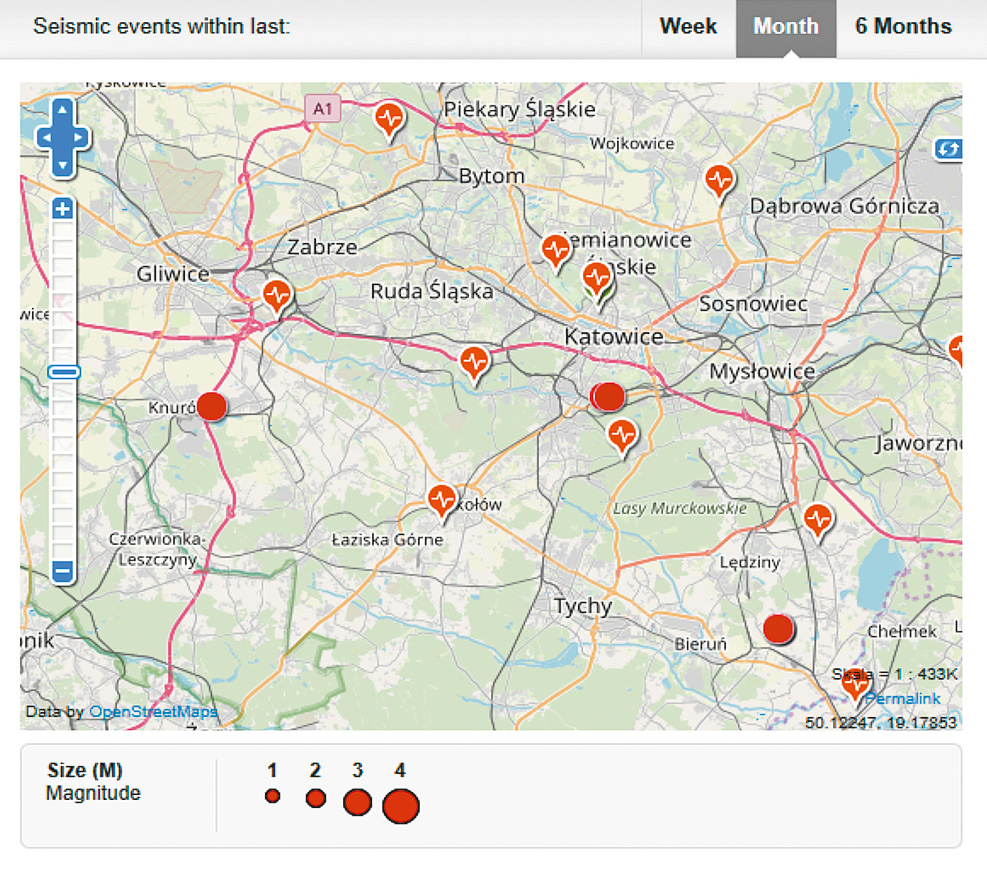
Fig. 2. Distribution of USRSN (orange marker) stations and tremors registered in March 2019 (red circle) (11).
In the years 2008 to 2017, 12,376 tremors with seismic energy of E ≥ 105 J occurred in the USCB mines, in 2017, 1,271 such phenomena were recorded. The quantitative distribution of registered tremors in individual energy classes is presented in Figure 3.
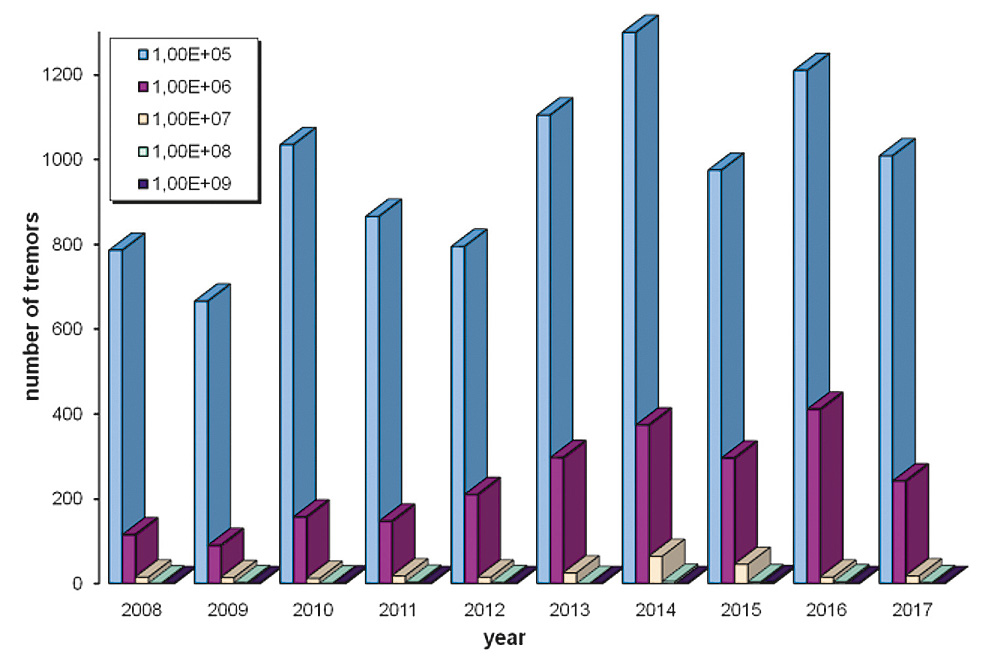
Fig. 3. Distribution of tremors with seismic energy of E ≥ 100,000 J in individual energy classes registered in the USCB region from 2008 to 2017 (own elaboration based on (8)).
The analysis of the distribution of tremors foci that occurred in the years 2008 to 2017 showed that they occurred, mainly in regions where the coal seams are deep, and in the construction of the rock mass there are thick sandstone layers and complicated tectonics.
During this period there were 21 rockbursts, which were accompanied by tremors of the rock mass with seismic energy in the range of 105 to 109 J. The average depth of the seam with which the occurrence of the phenomenon was related ranged from 585 to 1,150 m. Most of these tremors were connected with exploitation in the seams at a depth of 900 to 1,050 m. The amount of damage connected with rockbursts is primarily the number of accidents and the length of destroyed and collapsed excavations. Figures 4 and 5 present the distribution of the number of rockbursts and their effects from 2008 to 2017.
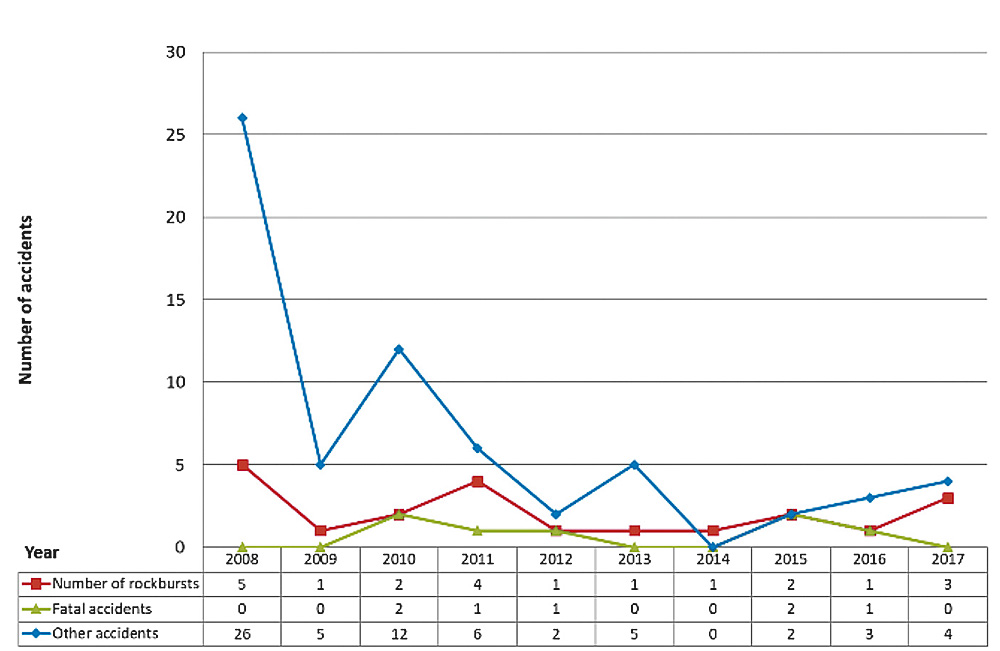
Fig. 4. The distribution of the number of rockbursts and accompanying accidents, including fatal accidents (own elaboration based on (8)).

Fig. 5. Distribution of the number of rockbursts from 2008 to 2017 and the accompanying results – destroyed and collapsed excavations (own elaboration based on (8)).
Methods for assessing the threat of rockbursts
The assessment of the threat of rockbursts is regulated by the provisions of the Instruction No 20 (12) concerning the principles of using the comprehensive method and detailed methods for the assessment of the rockbursts hazard in hard coal mines. The comprehensive method consists of mining exploration, seismological, seismoacoustic, probes drilling, and, if justified, other methods for assessing the actual threat of rockbursts. Other methods include the method of excited seismoacoustic activity (in the centers of longwalls or in the faces), seismic method (seismic screening between excavations or seismic profiling in the headings), geotomography method in active and passive variation, electro-resistance method, gravimetric method.
The mining exploration method is used to assess the potential rockburst hazard at the stage of mining works design. On this basis, long-term methods of combating or limiting the hazard are selected, i. e. optimization of the sequence of the seams selection, the location of excavations, the system of exploitation, methods and means of drilling excavations. The actual state of hazard is assessed by other methods. On this basis, the hazard condition of the excavation is assessed – an excavation which is not threatened by rockbursts, an excavation weak threatened by rockbursts, medium threatened by rockbursts and strong threatened by rockbursts.
Mining exploration method
The mining exploration method includes the analysis of the state of rockbursts hazard depending on the mining-geological conditions. The following factors are taken into account, among others: depth of conducting works, occurrence of rockbursts in the seam or in parts of the seam after 1980 or after 1970 under certain conditions, susceptibility of coal to the rockbursts or coal resistance on the uniaxial compressive strength, presence of thick layers of strong rocks in the seam roof, conducting excavation within the reach of the remnant or edges, adding up the influence of at least two remnants or edges, conducting the excavation in the destress layer of the thick seam, conducting the excavation in the bilateral environment of gobs, guiding the headings along gobs, approaching the gobs with the face, guiding the face in the neighborhood of the washing out lines or seams connection. Each factor receives a point value. The sum of points is a measure of the threat condition of a given excavation.
Seismological method
The essence of the seismological method is the registration and analysis of tremors induced by mining exploitation. In this method, it was assumed that each mining excavation has its own characteristic level of seismicity, which can be safe for it and results from the mining-geological conditions in its region. The accepted safe state is a reference for the next time interval. Changes in the level of seismicity have the characteristics of time-space anomalies of specific quantities that characterize the seismicity of a given rock mass formation and resulting from mining-geological conditions. The size of the excavation areas is adopted depending on the accuracy of the location of the tremors, whereby they cover at least the area of the dimension of 200 m in the direction of the advance and gobs, and every 50 m to the side outside the longwall area, for headings it is an area with a radius of 100 m from the front of the heading. The seismological assessment also takes into account the type of excavation, the method of seam floor management and the type of a support. A distinction is made between qualitative and quantitative seismological criteria for the rockburst hazard assessment. The initial level of seismicity is based on seismological observations recorded in a sufficiently long time. The qualitative criteria include general relationships:
- The change in the parameters describing the level of seismicity indicates a change in the stress-deformation state and may indicate an increase or decrease in the rockburst hazard.
- Changing the parameters of seismicity by increasing the number of tremors in a constant unit of time, progress or technological cycle with the simultaneous increase in their seismic energy is a sign of increased threat. If their seismic energy is reduced, this is a sign of reduced threat.
- If the number of tremors per time unit, progress or technological cycle decreases and lasts for at least several production cycles (minimum 20 m of progress), it is a sign of a reduced threat. With simultaneous increase in seismic energy of tremors this is a sign of increased hazard.
Quality criteria based on the change of the position of the tremors focus require a high accuracy of location of focal points, which is not always possible. The analysis may also cover the total seismic energy released per unit of the exploited area (or volume). The threat is considered to be higher the higher is the value of this parameter, in particular when the seismic energy is released less frequently but in the form of high-energy tremors.
Quantitative seismological criteria should be created based on the results of empirical material analysis. The assessment of the threat of rockbursts is made on the basis of the following basic parameters:
- level of natural seismicity of the rock mass – in the area of the observed excavation – based on the energy-frequency distribution (number of tremors in individual energy classes and maximum seismic energy of the tremor Emax);
- sum of seismic energy of tremors Σ E released in a specific unit of time, progress Σ E/5 m, technological cycle Σ E/cycle.
Standard values of the above-mentioned parameters in the conditions of the USCB mines, are included in the work (12). These values, as recommended, each mine should adapt to its own mining-geological conditions as well as individual exploitative areas of mines.
Determination of the threat state is based on seismological parameters according to the principle that the state is equal to the highest one determined by one of the two basic para-meters. The threat states are marked as follows: a no threat, b weak threat, c medium threat, d strong threat.
The state of increased rockburst hazard determined by the seismological method is valid 24 h after the occurrence of tremor causing an increase in the assessment. If there are no indications to maintain or increase the evaluation, the threat reduction takes place gradually. Every 24 h, at most by 1 °.
On the basis of seismological observations one can conclude on the effectiveness of prevention measures, i. e. the effectiveness of blasting.
Seismoacoustic method
The seismoacoustic method is based on the analysis of seismo-acoustic emission, i. e. emissions associated with the production of elastic waves in rocks during dynamic processes. These waves diverge from the focus to the boundaries of the center and can be recorded as seismoacoustic impulses. During the propagation of waves in the rock, higher frequencies are gradually filtered out and a relative increase of components with lower frequencies is observed. Changes in seismoacoustic emission correlate with stress changes and may signal the moment of sudden energy release. Before destruction, the focal points of the impulses focus on the surface of future destruction.
According to the recommendations, seismoacoustic observations are made in the areas and excavations indicated by the chief engineer of rockbursts. Such observations should be carried out in active longwall and shortwall excavations as well as active heading faces in conditions of the highest degree of rockbursts threat. Observation results can be used to identify the threat condition of a mining excavation or part of a seam threatened by the rockbursts, current determination of hazard changes and the assessment of rockbursts precention. Seismoacoustic apparatus, a network of geophones, transmission lines and receivers are the technical equipment of the method. Observations should be carried out continuously. Interpretation of the results is performed in the shift or hourly span on the basis of seismoacoustic activity measurements, measurements of the size representing total energy, mining-geological data and motion data. The indicators of intensity of seismoacoustic phenomena are determined, followed by the deviation of value of individual indicators. The assessment of the threat condition takes place by comparing the values deviations. Four threat states are determined: a no threat, b weak threat, c medium threat, d strong threat. The detailed requirements were determined for seismoacoustic observations of longwalls, i. e. above 200 m.
Drilling method for small diameter holes
In the method of drilling small diameter holes, it was assumed that in the sidewalls seam parts there is an increased state of stress, which is accompanied, in the case of holes drilling, the increased outcrop of drill cuttings. This outcrop results from the loss of stability of the hole walls and the movement of coal to the inside of the hole. Increased outcrop can also be the result of the destruction of the carbon structure or its small cohesion. A drilling probe made by means of small diameter holes, of a diameter of 42 or 48 mm (+/- 1 mm). This allows the detection of the zone of increased stress in the coal seam near the sidewall or in the face of the excavation, which in turn may indicate a threat of rockbursts, mainly seam rockbursts. The method can be used to assess the stress state of the sidewalls parts of the coal seam. The excavations for which a drilling probe should be used are determined by the mining team for rockbursts. Drilling in longwall excavations is carried out in zones with a width of 10 to 20 m. The number of zones is determined for each face individually. The distance of the extreme zones from the headings should not be less than 15 m. In dog headings, drillings are performed in the face and in the sidewalls at a distance of 2 to 30 m from the face or in other places depending on local conditions. A bulk volume of drill cuttings is determined after each meter of the drilled hole. The holes should be made in undisturbed soil to a depth of 3.4 m, where M is the height of the exploitation port. In justified cases, larger drilling depths can be used.
During drilling, observations of the occurrence of knocks, glitches, pulling the drill in, increase in drill cuttings granulation and drill jamming are made. The occurrence of the above mentioned and the statement of a critical outcrop of drill cuttings testifies to the threat of the excavation. The bulk volume of drill cuttings from a 1 m section of the hole: 6 l for holes with a diameter of 42 mm, 8 l for holes with a diameter of 48 mm is considered as the critical outcrop of the drill cuttings. Detailed rules for applying the method, and assessment criteria together with the interpretation of measurement results are included in the Instruction (12). The scale of hazard assessment in the mine excavation according to the discussed method includes four states: a no threat, b weak threat, c medium threat, d strong threat.
Rockbursts prevention
Prevention of rockbursts involves activities before and during exploitation. Before commencing the exploitation, it is essential to properly develop an exploitation project that takes into account requirements concerning long-term prevention, including:
- determining the correct sequence of seams or layers selection;
- optimization of the cut;
- conducting a stress relief exploitation, or organizational and technical activities, including the selection of a support;
- determination of special threat zones.
At this stage, analytical methods of the assessment of the rockburst hazard state are used, on the basis of which forecasts of stress concentration sites, a seismic hazard forecast, or rockbursts threat classification are performed.
During exploitation, current control of hazard condition is performed using several assessment methods described in point 3 and active prevention methods of mining works are used, such as coal and rock irrigation in high and low pressure version, destress blasting or destress-mining blasting in the coal seam and destress blasting in the seam roof or seam floor, directed rock fracturing in a hydraulic version (UHS) and by the blasting technique (USS).
Exploitation in the conditions of rockburst hazard – a case study
The issue which is the subject of the article will be presented on the example of activities carried out to limit the threat of rockbursts in the area of exploitation conducted by one of the mines in the USCB region. Currently, the seismic network of the described mine consists of 26 underground seismometric stations. In the region of the mining plant concerned, up to now 28 dynamic phenomena have been classified as a rockburst. The last rockburst took place in 2016. The rockburst was caused by the tremor at the energy of 2 · 106 J. So far in the mine, 67 % of rockbursts occurred during longwall exploitation, 33 % of rockbursts occurred in the hollow heading excavations. The examples of the effects of the rockburst in the excavation are shown in Figure 6.
In the following, the characteristics of the applied methods in the area of exploitation conducted along the longwall in the seam C will be presented. The seam lies in this part at an average depth of 1,050 m. Coal endurance for uniaxial comprehensive strength Rc is 28 MPa, which qualifies it as prone to rockbursting. The works were conducted with a fall of roof to a height of 2.5 m in the region of the beginning of the longwall to approximately 1.5 m in the region of its ending. On the longwall enclosure occurred the edges of the seam B which lies about 51 m above the seam C and the remains of the seam A which lies about 138 m above the seam C, in the seam roof was found the occurrence of cohesive rocks that are susceptible to the accumulation of elastic energy (Figure 7).

Fig. 7. The mining situation in the area of exploitation conducted along the longwall 2 in the seam C (own elaboration based on (13)).
During the longwall run, high induced seismic activity was observed. 5,842 tremors with energy of the range of 102 to 107 J were recorded, including 78 high-energy tremors.
The seam was classified to the 3rd degree of rockbursts threat (currently II). The assessment of the hazard state was carried out on an ongoing basis in accordance with the instruction. Mining exploration methods, seismology and seismoacoustic method, small-diameter drilling method and cyclic seismic observations were applied.
Seismic surveys were carried out using PASAT-M apparatus, which enables registration of artificially excited seismic waves after their passage through the investigated area by means of vibration receivers (geophones) distributed in a known way. As a result of the assessment of the state of hazard, four stages of the longwall run were identified during which appropriate measures of active prevention were applied. The seismic activity in individual stages of the longwall run is included in Table 1.

Table 1. Seismic activity recorded in the separated periods of the longwall run (own elaboration based on (13)).
The distribution of foci of the high-energy tremors is shown in Figure 8.
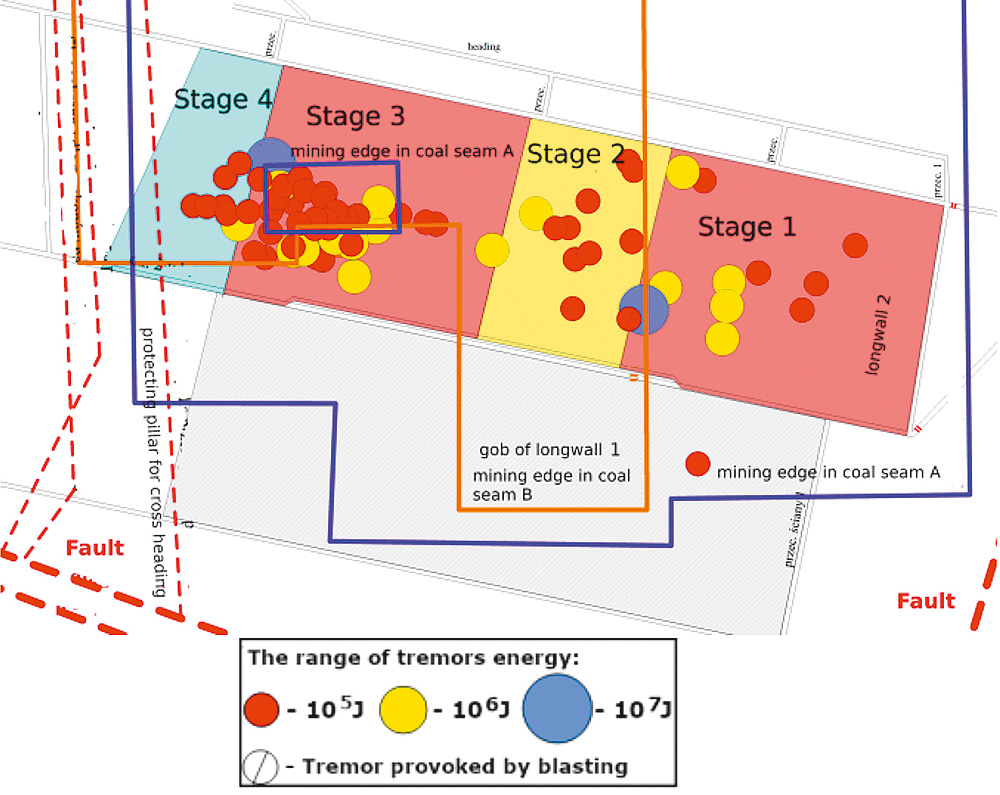
Fig. 8. Distribution of the foci of the high-energy tremors, recorded during the longwall no 2 run (own elaboration based on (13)).
The total seismic energy induced by the conducted workings was 15 to 16 · 107 J, with an average energy output of 132 J/t.
In order to limit the threat condition, active prevention was applied, within which the torpedo blasting was performed to disintegrate the roof rocks and destress blasting. The scope of the blasting was determined additionally, cyclic seismic tests were performed by means of the screening method in order to better recognize the state of stresses in the seam and rocks directly surrounding the seam. The results of seismic geotomography in the area of co-occurrence of the exploitation and remnants are presented in Figures 9 and 10.
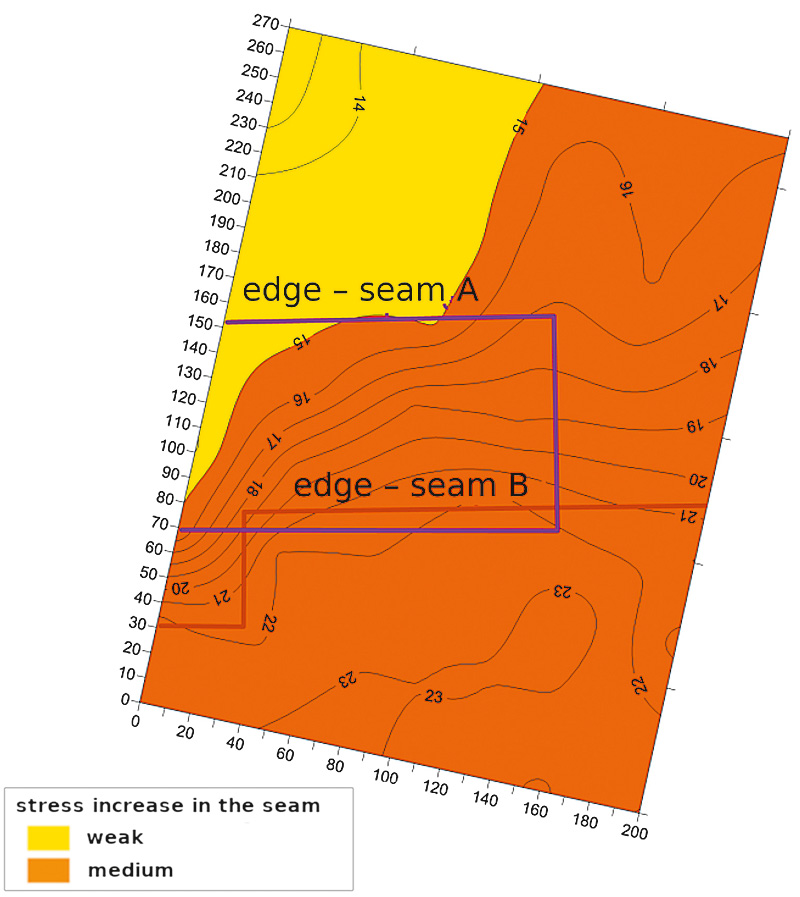
Fig. 9. Results of seismic geotomography in the region of remnants location-stress in the seam (own elaboration based on (13)).

Fig. 10. Results of seismic geotomography in the region of remnants location – rock susceptibility to rockburts (own elaboration based on (13)).
In connection with the results of seismic geotomography, in order to destress the seam C, in front of the longwall the destress blasting was introduced from the longwall face (Figure 11).
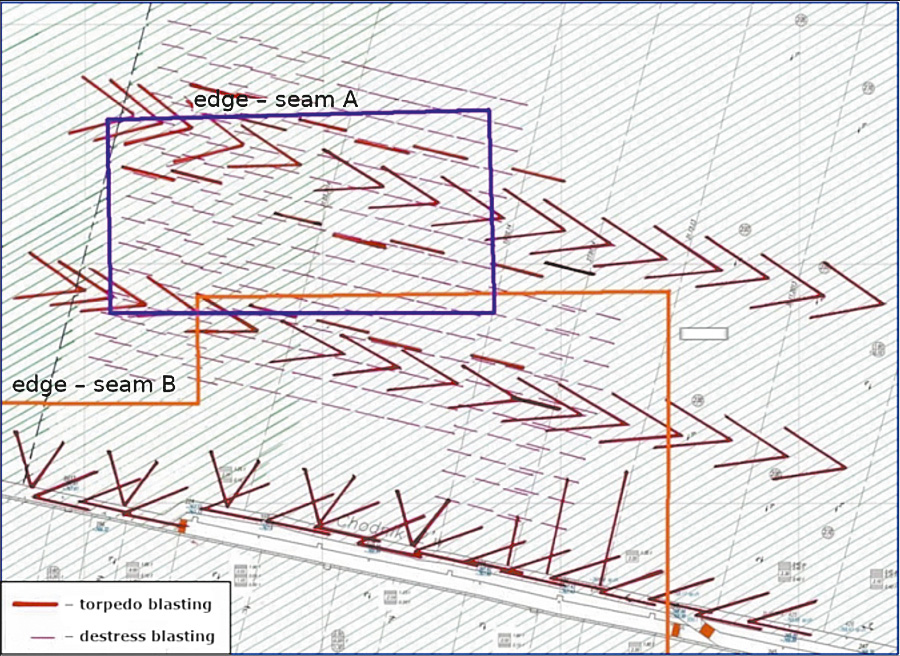
Fig. 11. Active prevention – distribution of the holes for blasting for the longwall 2 in the seam C in the area of coexistence of exploitation and remnants in the seams A and B (own elaboration based on (13)).
Detailed data concerning rockbursts prevention in the longwall is presented in Table 2.
Blasting caused the release of 3.37 · 106 J of seismic energy. The location of the holes for torpedo blasting and destress blasting in the area of the 3rd longwall run is presented in Figure 9. The scope of active prevention and distribution of the tremors foci provoked by blasting are presented in Figure 12.

Fig. 12. Distribution of active prevention and the tremors focus provoked by blasting (own elaboration based on (13)).
Conclusions
The article presents the methods for the assessment of the rockburst hazard and the prevention of the preventing the rockbursts used in Poland. This is an extremely important issue because it concerns many mining coal basins in the world. Not only hard coal mining but also other minerals like copper ore or gold.
The problem is all the more important because the exploitation of deposits at ever deeper depths is observed, which means that it takes place under conditions of increased state of stress in the rockmass. The example presented in the article confirms that the current assessment of the rockburst threat on the basis of which active prevention is selected effectively counteracts the occurrence of rockbursts, which is the main goal of all activities carried out in order to limit the rockburst threat. It should be noted that it is beneficial to use new mining techniques and technologies as well as to improve the methods of hazard assessment and methods of rockburst prevention, to which force the changing conditions of mining exploitation.
References
References
(1) Gibowicz, S.J. (1963): Klasyfikacja energetyczna wstrząsów podziemnych na Górnym Śląsku i częstotliwość ich występowania w zależności od wielkości energii. Archiwum Górnictwa. t. VIII, z.1, Warszawa, pp 17 – 41.
(2) Mutke, G.; Lurka, A.; Mirek, A.; Bargiel, K.; Wrobel, J. (2001): Temporal changes in seismicity and passive tomography images: a case study of Rudna copper ore mine-Poland. 5th Intern. Symp. Rockbursts and Seismicity in Mines – Dynamic rock mass response to mining. The South African Institute of Mining and Metallurgy, pp. 237 – 330.
(3) Sokoła-Szewioła, V. (2008a): Seismicity induced with conducted mining exploitation-selected issues. Silesian University of Technology, Gliwice, 2008.
(4) Sokoła-Szewioła, V. (2008b): Method of evaluating the probability of a strong tremor. 21st World Mining Congress. New challenges and visions for mining. Risk management & subsidence engineering. Sustainable development in mining industry (incl. mine closure), Kraków, Polish Academy of Sciences. IGSMiE PAN, Kraków, pp 41 – 49.
(5) Sokoła-Szewioła, V. (2011): Method of forecasting the seismic energy induced by longwall exploitation based on changes in ground subsidences. Mining Science and Technology. Vol. 21, No 3, China, pp 375 – 379.
(6) Bańka, P. (2018): Reconstruction of the acceleration field of ground vibrations taking into account the directivity of vibrations’ propagation. IOP Conference Series; Earth and Environmental Science, vol. 198, pp 1255 – 1315.
(7) Regulation (2015): Rozporządzenie ministra środowiska z dnia 29 stycznia 2013 r. w sprawie zagrożeń naturalnych w zakładach górniczych. DZ.U., Poz.1702.
(8) Kabiesz, J. (2018): Raport roczny 2017 o stanie zagrożeń naturalnych i technicznych w górnictwie węgla kamiennego, GIG. Katowice.
(9) WUG, 2018. Ocena stanu bezpieczeństwa pracy, ratownictwa górniczego oraz bezpieczeństwa powszechnego w związku z działalnością górniczo-geologiczną w roku 2017. Wyższy Urząd Górniczy, Katowice.
(10) Dubiński, J.; Konopko, W. (2000): Tąpania – ocena, prognoza, zwalczanie, GIG, Katowice.
(11) GIG – http://www.grss.gig.eu/pl/
(12) Barański, A.; Drzewiecki, J.; Kabiesz, J.; Konopko, W.; Kornowski, J.; Krzyżowski, A.; Mutke, G. (2007): Zasady stosowania metody kompleksowej i metod szczegółowych oceny stanu zagrożenia tąpaniami w kopalniach węgla kamiennego. GIG, seria: Instrukcje, No. 20.
(13) Pietrzycki, A. (2018): Zagrożenie Tąpaniami, Engagement Event – SafeDeepMining – EIT Raw Materials, 4/09/2018. Silesian University of Technology. Gliwice.
